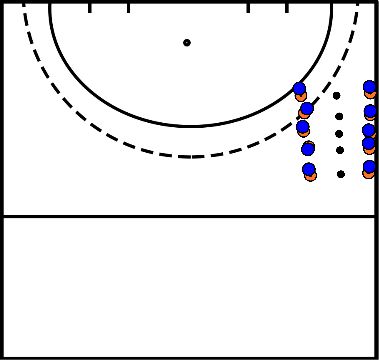Hockey drills
Overrun
- All but one player start with ball on the line.
- They try to reach the other side of the field without losing the ball.
- The defender -player red- tries to take the ball from the players -blue- and work it out of the box.
- If a player loses his ball and the ball is played out of the box then he is finished.
- He then helps the defender to take the balls off and work them out of the box.
- The game continues until all players are finished.
- The player last left wins the game.
Points of Attention:
- Is the game finished, start over with another defender.
- If the player commits a foul, he is also finished.
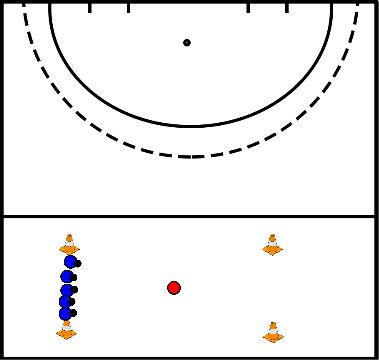
Superslalom.
You can perform this slalom in 4 different ways:
You can perform this slalom in 4 different ways:
- Normal slalom: player and ball move forward through the gates.
- Player keeps moving to the left of the gates and has the ball on the right side of his body.
- Player continues to move to the right of the gates and has the ball on the left side of his body.
- Player moves to the left of the first gate and ball passes on the right, player moves to the right of the second gate and ball passes on the right. The player continues to alternate this until the end of the slalom.
After the slalom, the player rounds the ball on goal and rejoins the back of the line.
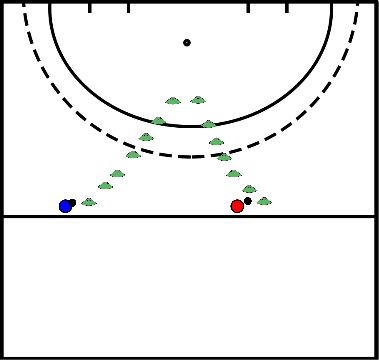
Handball -one touch-.
- Player blue begins to move in a lateral direction. So the initiative lies with this player.
- Player red pushes the ball straight to player blue.
- Player blue rebounds the ball sideways.
- Player red has moved on, takes the ball and scores.
- Having scored, you rebound and visa versa.
Points of attention:
- Player blue must make sure he is well turned in at the time of handball.
- Make sure you have your stick well in front of your body at the moment of handball.
- Also pay extra attention when rounding on goal, preferably a flat.
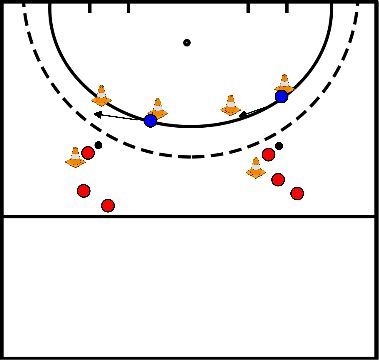
Dummy:
- The player does three passes behind the dummy and rounds on target.
- You can also do this exercise in relay form (do emphasize the proper execution of the exercise and not the speed).
Points of attention:
- With the dummy, it is important that you pretend to pass to the left, but eventually accelerate right around the pawn.
- Make sure you step out well with your left foot and pass the ball well under you.
- After your move, accelerate briefly to the next double pawn.
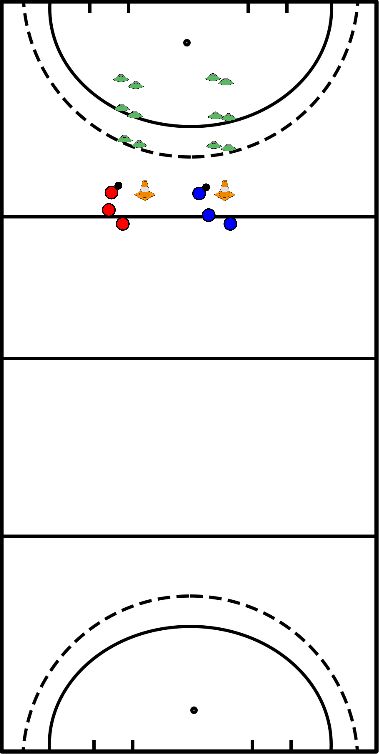
- All but one player have a ball.
- The player without ball is the defender and tries to work all the balls out of the square as quickly as possible.
- The players with ball drift through the square and try to keep the ball there as long as possible.
- If the player loses his ball and the defender plays the ball outside the square, the player is finished.
- In that case, he helps the defender to work all the balls out of the square as quickly as possible.
- The player who remains last with ball wins the game.
Points of Attention:
- Emphasize that the players look well over the ball while drifting (head up).
- If a foul is made by the player with ball, he is out. If the defender fouls, it is a free ball for the attacker.
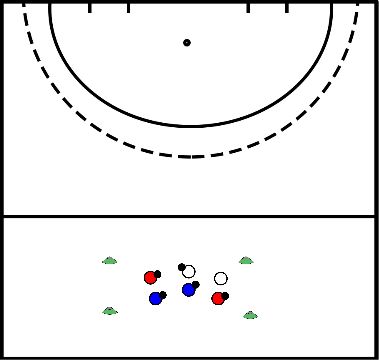
1 vs. 1
- Attacker blue plays the ball with a push pass to defender red.
- Defender red accepts the ball and plays the ball with push pass back to attacker blue.
- Attacker blue takes the ball and plays a 1 vs. 1 with the blue defender in the square.
- Does the attacker win the duel he may score freely. The defender does not have to pass if the 1 vs 1 is lost in the square.
- If the defender takes the ball away, he makes sure the ball is played through the orange gate.
- The attack is finished when the attacker has shot at goal or the defender has played the ball through the orange gate.
Points of attention:
- Focus is both on defending -poking, sitting low, not stepping in- and attacking -tempoing, direction changes, etc.
- Depending on the number of players, the exercise can be plotted twice.
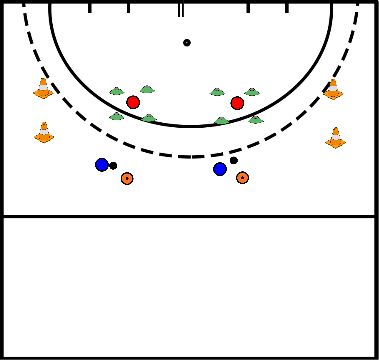
- Make two rows of an equal number of players.
- Players take turns drifting toward the three double pawns.
- Arriving at the double pawns, do the herring trick three times in a row and then flatten the ball on goal.
Herring trick:
- You play the ball to the right of the double pawn and pass it yourself to its left.
- Make sure you have control of the ball again before the next double pawn.
- So push the ball in a controlled manner.
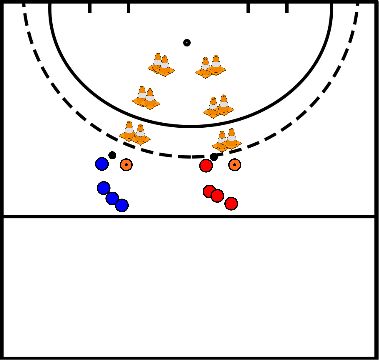
Party with four goals.
- The coach makes two equal teams.
- Each team defends two goals.
- It is allowed to play field hockey behind goal, but scoring is only allowed at the front.
Points of attention:
- Play with the 3 second rule; take the ball quickly after a foul. Takes longer than 3 seconds, free hit for the opposing team.
- If it is crowded on one side of the field, move the ball at pace to the other side where there is more space.
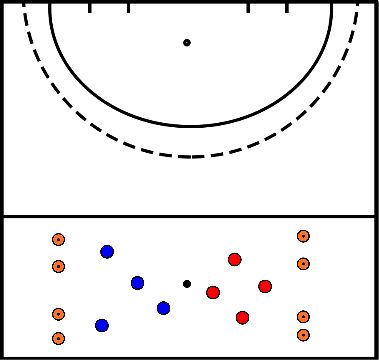
Party with four goals.
- The coach makes two equal teams.
- Each team defends two goals.
- It is allowed to play field hockey behind goal, but scoring is only allowed at the front.
Points of attention:
- Play with the 3 second rule; take the ball quickly after a foul. Takes longer than 3 seconds, free hit for the opposing team.
- If it is crowded on one side of the field, move the ball at pace to the other side where there is more space.
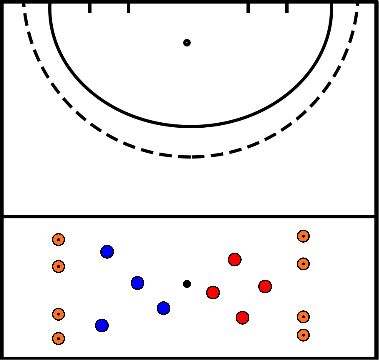
Relay
- Create two equal teams.
- Start the relay at the coach's signal.
- The player slaloms around the pawns -both ball and body around the pawns- and rounds on goal -push or flush-.
- If the player scores, he may immediately sprint back and tap the next player.
- If the player misses, he must take a detour via the blue pawn -on the side of the field- and then sprint back and tap the next player.
- When it's your turn, you sit down on the ground.
- Depending on the number of players, you can also choose to have all players take 2 or 3 turns.
- The next player may not start until he is tapped by the player in front of him.
- The team that has all players on the ground first wins the relay.
- There are different types of slalom to apply in this exercise:
- Normal slalom
- Slalom in which the player's body and ball are to the left or right of the row of pawns.
- Slalom where the ball is to the left of the row of pawns and the body is to the right.
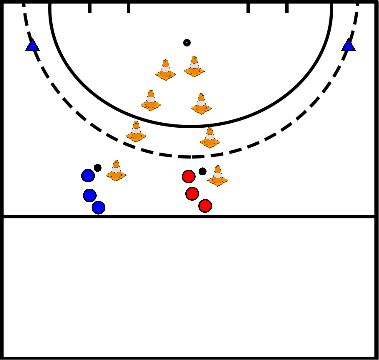
- Piece float.
- Indian dribble.
- Forehand - then take backhand ball - red-.
- Backhand - then take backhand ball - blue-.
- Expand to relay and switch sides.
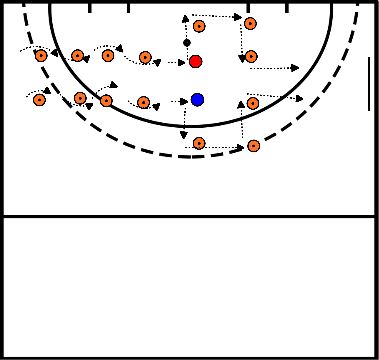
Put out as many times as there are players:
- Each player has their own pawn.
- They play 1-1 with the person opposite them.
- The ball is in the middle.
- At the whistle, they start trying to tap the other person's pawn.
- After a certain time, blow the whistle.
- Player who won moves one space to the right on the loser 1 to the left.
- In case of a tie; stone paper scissors.
